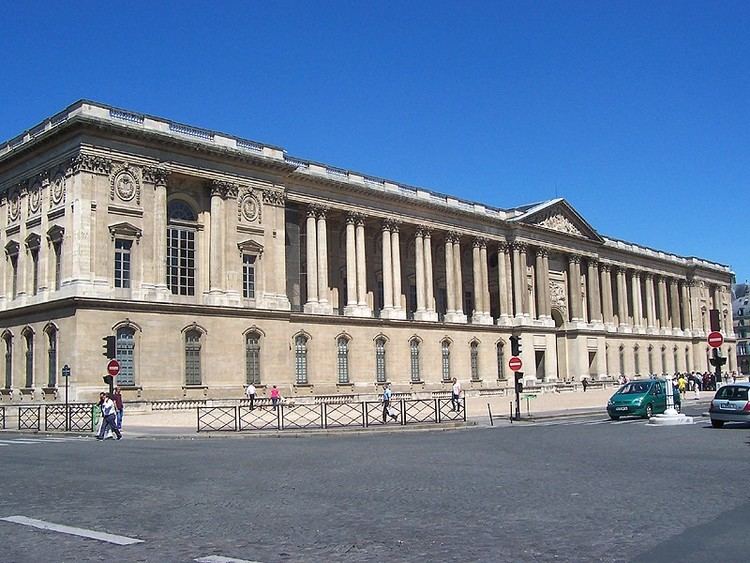Phone +33 1 40 20 50 50 | Architect Claude Perrault | |
 | ||
Address Place du Louvre, 75001 Paris, France Hours Open today · 9AM–6PMMonday9AM–6PMTuesday9AM–6PMWednesday9AM–6PMThursday9AM–6PMFriday9AM–6PMSaturday9AM–6PMSunday9AM–6PMSuggest an edit Similar Pavillon de l’Horloge, Hôtel du Petit‑Bourbon, Saint‑Germain l'Auxerrois, Lescot Wing, Pavillon de Flore | ||
Claude Perrault's Colonnade is the easternmost façade of the Palais du Louvre in Paris. It has been celebrated as the foremost masterpiece of French Architectural Classicism since its construction, mostly between 1667 and 1670. Cast in a restrained classicizing baroque manner, it interprets rules laid down by the ancient Roman architect Vitruvius, whose works Perrault had translated into French. Architect Louis Le Vau and artist Charles Le Brun also contributed to the realization of Perrault's work.
Contents
Description
Little that could be called Baroque can be identified in Perrault’s cool classicism that looks back to the 16th century. The façade, divided into five parts, is a typical solution of French classicism. The simple character of the ground floor basement sets off the paired Corinthian columns, modeled strictly according to Vitruvius, against a shadowed void, with pavilions at the ends. This idea of coupled columns on a high podium goes back as far as Bramante. Those rhythmical columns form a shadowed colonnade with a central pedimented triumphal arch entrance raised on a high, rather defensive base. Crowned by an uncompromising Italian balustrade along its distinctly non-French flat roof, the whole ensemble represents a ground-breaking departure in French architecture.
History
Perrault (1613–1688) won the competition held by Louis XIV for a design for the eastern façade of the Louvre Palace, beating out even Gian Lorenzo Bernini, who had traveled from Italy expressly for the purpose. This work consumed Perrault from 1665 to 1680, and established his reputation: the severely designed colonnade overlooking the Place du Louvre — for which buildings including the Hôtel du Petit-Bourbon were demolished to provide the necessary urban space — became widely celebrated.
In 1964, the French Minister of Culture, André Malraux, ordered the digging out of the dry moat in front of Perrault’s Colonnade. A characteristic feature of French classical architecture, it is shown in nearly every project and early drawing of the east facade, and its reexcavation revealed the original soubassement, or podium (see the engraving from Blondel's book). The moat may have been filled in around 1674 to facilitate construction (see the engraving by Sébastien Leclerc) and not restored due to lack of funds to build the contrescarpe after Louis XIV's attention shifted to the Palace of Versailles. However, in 1981 Germain Bazin argued that the reconstruction of the moat was misguided, since for aesthetic reasons Louis XIV had never wanted it.
Influence
For centuries, Perrault’s Colonnade has provided a model for many grand edifices in Europe and America:
